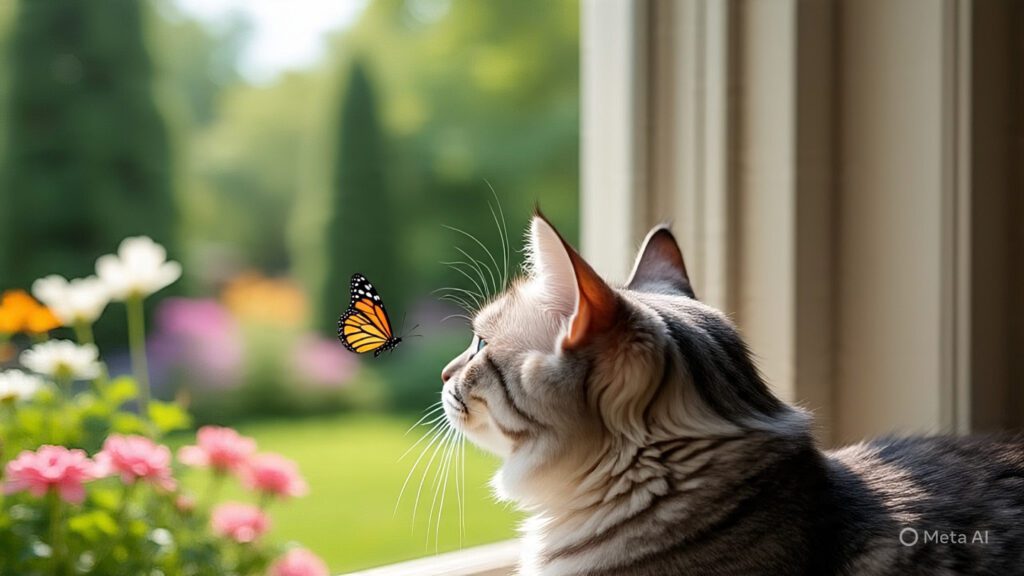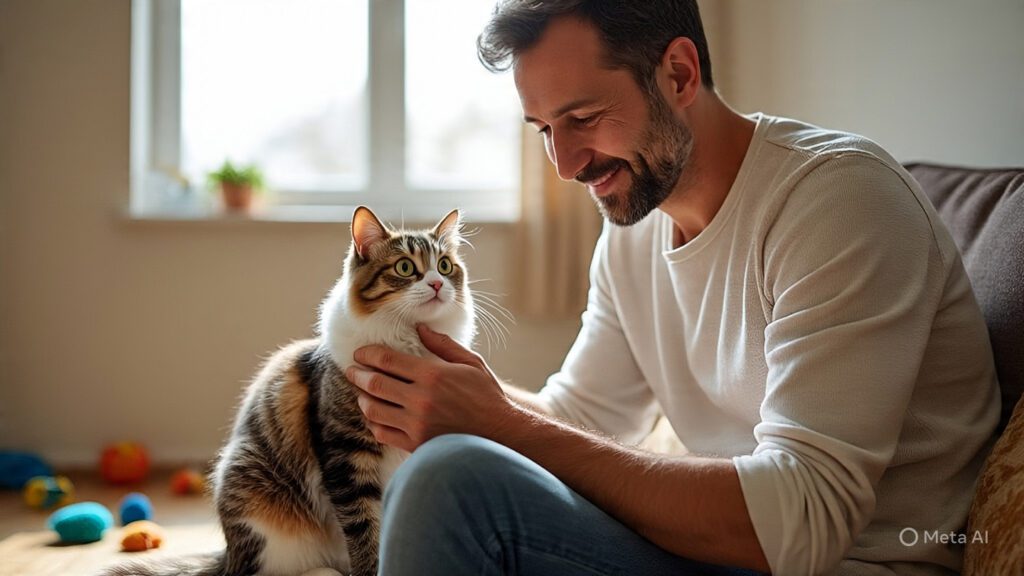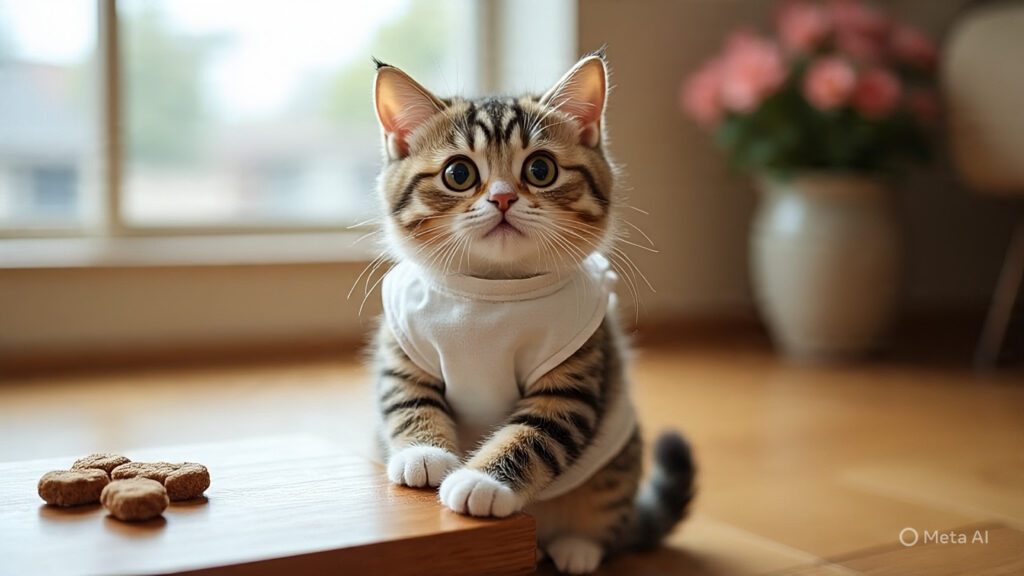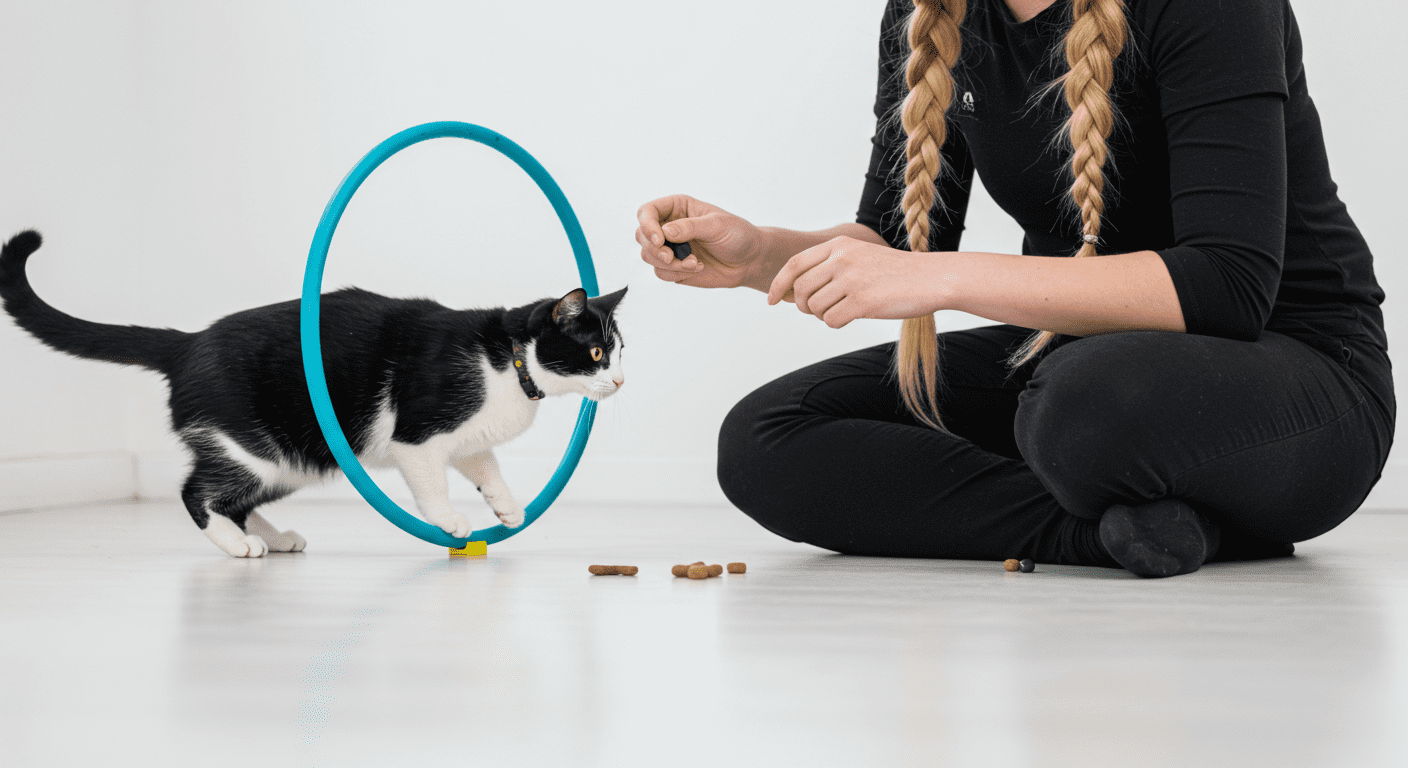Please Note: This post may contain affiliate links. If you click one of them, we may receive a commission at no extra cost to you. As an Amazon Associate, I earn from qualifying purchases.
Teaching a cat to do something? Sounds a little strange and not real. But you should think like a Southerner. We don't usually think that cats are that smart, but you can definitely exploit the chances you have to encourage them to do more than just knock things off tables.
Isn't it amazing that we can call our cats and they'll come to us or even use the bathroom? That's a lot to ask, so let's look at some more helpful advice!
Top Takeaways and Key Concepts
- Understand your cat’s perspective and motivators, such as treats, toys, or sunbathing.
- Use positive reinforcement immediately after desired behavior to strengthen learning connections.
- Keep training sessions short, no longer than five minutes, to maintain focus.
- Teach one command at a time and remain consistent with all household members.
- Celebrate small wins and adjust training for distractions or your cat’s mood.
Article Summary
The text emphasizes that training cats requires patience, understanding, and positive reinforcement. Cats respond best when their unique preferences and motivators are considered, and rewards are given immediately after correct behavior. Short, focused sessions improve attention, while teaching one command at a time and maintaining consistent language across family members prevents confusion. Flexibility is important, as distractions or moods may interfere with learning, and celebrating small successes keeps both the cat and trainer motivated. Ultimately, building a strong bond with your cat enhances training success.
Video Summary
Handy Amazon Shopping Directory for Cat Supplies
Cat Food - Cat Toys - Cat Health - Grooming - Carriers - Cat Beds - Apparel
Furniture - Cat Doors - Collars - Feeding/Watering - Flea/Tick Control - Treats
Jump to Content
Seeing Things from the Cat's Point of View

Oh, and before I forget, when it comes to training, your cat thinks very differently than you do. To get them to comprehend what you want them to do, you need to explain why you want them to do it.
Cats do what they want, but dogs don't. So don't expect your dumb fluff ball to want to satisfy you like a dog would. They are like privileged little furry superheroes who can purr.
What do you believe makes your cat want to do things? … toys, sweets, or lying in the sun? Every cat has its own tastes and dislikes.
Fluffy, my cat, loves tuna so much that she would sell her soul for it. Or maybe she would sell it to me while pretending to ignore me with a feather toy she is tired of.
Both you and your cat need to know how important it is to divide training up into small, easy-to-handle pieces. This method makes learning less stressful for both you and your cat, and it lets your cat learn new instructions and behaviors at a speed that is appropriate for them. Cats can be easily distracted and may not be able to focus for as long as other pets, so breaking up training sessions into shorter periods will help them learn better.
As you start to teach Fluffy new tricks or reinforce old ones, keep in mind that patience is really important. Training a cat doesn't happen quickly. It takes patience, persistence, and a willingness to change your approaches when necessary. You should get ready for what might be a long training season with a lot of ups and downs. Fluffy will have days when she wants to learn and days when she would rather lie in her favorite sunbeam or curl up for a snooze.
For example, when you say “Sit,” Fluffy looks at you with no interest and then lies back down to sleep. Recognizing that this behavior is completely normal is really important. Cats are known for their love of sleeping. After all, who wouldn't want to take advantage of all that time they spend lying around? Instead of becoming angry at her for not being excited during training, laugh and understand these times.
Think about changing what you expect. If Fluffy decides that today is a day for more snoozing than practicing instructions, let her do it! Take this time to connect with her in different ways, like by gently caressing her or just sitting quietly with her while she sleeps. These calm times can be just as helpful as training sessions since they help you and your dog trust and feel comfortable with each other.
Also, remember that each cat is different and learns in its own way. Some people may respond right away to verbal signals, while others may need visual clues or even treats to get them to do what you want. Trying out different methods will help you figure out what works best for Fluffy and keeps her interested during training.
As you teach your cat new things or reward excellent behavior, enjoy the minor wins along the road, even if they don't seem like much at first. Every little step forward counts, whether it's getting her to sit for a minute or just watching her show interest in what you're doing.
In the end, be patient and open-minded as you go through the training process. Keep in mind that it's fine if some days are more about sleeping than learning. What really important in creating a strong friendship with your furry friend is spending quality time together.
The Key to Success: Positive Reinforcement

If I had to give you one piece of advice, it would be to use positive reinforcement.
It's weird, but picture what would happen if everyone could say something like, “It's a great day, let's do some exercises and have a blast,” instead of telling someone they're wrong for not doing what they were told to do.
This is how things should be, and most individuals can handle their jobs “by doing things right” without being made fun of.
It goes back to this quote: “Everyone loves to be rewarded,” and Fluffy loves to get a treat. And as everyone has a favorite treat, Fluffy does too, and if you give her her favorite treat, she will finally get up.
As soon as your kitten stands up, you should give her a treat or praise right away. This immediate reward helps her understand that standing up leads to good things. Cats are naturally interested, so when you treat them immediately away, you're playing into their propensity to look for actions that will get them rewards.
When it comes to training approaches, timing is quite important, especially when it comes to dealing with habits that won't go away. For example, if you want your kitten to sit down when you tell her to, you need to give her a reward right after she does it. This quick feedback helps her remember the behavior and makes the link between sitting and getting a reward stronger.
On the other hand, if she has to wait too long to obtain any recognition, such until dinner time, she could not connect what she did earlier with the reward she gets later. She might not comprehend that sitting leads to positive reinforcement; she might just think that wonderful things happen at random times during the day. This lack of clarity can make it harder for her to learn and understand what you want her to do during training sessions.
For instance, picture this: you tell your kitty to sit, but then you wait a few minutes before giving her a treat or some love. At this point, she might have entirely forgotten what you told her to do and be focused on other things around her or even on food! If there is a long time between sitting and earning a reward, it is quite unlikely that she will connect the two.
To eliminate this confusion and make your training more effective, always try to give rewards right away. Using incentives, vocal praise like “Good girl!” or gentle patting right after she does what you say are all good ways to reinforce her comprehension of what behaviors you want her to do.
Also, think about changing up your prizes every now and then to keep things fresh for your kitten. Some days might need tasty snacks, while others could need fun playtime with a beloved toy. Changing how you reward her will not only keep her interested, but it will also reinforce the idea that good behavior can lead to different kinds of fun and happiness.
In short, timing is very important for training cats. Giving your cat a treat right after it does something you want it to do makes it easier for them to remember what they did and helps them develop good habits over time. Keep in mind that being patient and giving your animal companion timely praise are important when teaching them new abilities!
Short Sessions: Be Aware of Your Limits of Focus

Let's have a look… Cats aren't the most mysterious animals in the world. When you compare them to goldfish in concentration, they look very sad.
It's best to perform it in small chunks, no more than five minutes at a time. You will find that the shorter the time, the less likely Flufff and you will grow bored and go crazy. This will save you from getting dry gulches.
It's important to only work on one command at a time during these short training sessions. Trying to teach your kitten more than one command at a time can make things hard for both of you. For example, if you want her to “sit” and “high five,” you can find yourself in a funny predicament where she waves her paw around instead of sitting down. Instead of getting things done, you'll probably just wind up with a fun distraction that makes you both laugh but doesn't get anything done.
This shows how important it is to be clear and simple while training. If you only give your kitten one order, like “sit,” she will be able to fully grasp what you want her to do without getting any confused messages. This targeted method not only helps you learn, but it also makes your friendship with your animal pet stronger.
Also, it's important to be consistent with orders. Everyone in the house, including family, friends, and caregivers, needs to use the same words when delivering orders like “come,” “stay,” or “no!” Fluffy gets really confused when everyone uses various terms or phrases to mean the same thing. She might start linking different words to the same acts, which would make her second-guess what to do when someone asks her.
Fluffy might hear one person say “come” and another say “get over here.” This discrepancy can be confusing; instead of learning well, she may just get angry or not care about commands at all. Set up a family agreement on which orders will be used all the time so that she doesn't have to deal with this extra stress and so that she knows what is expected of her.
Keeping your language the same during training sessions will help Fluffy understand things better. She'll start to recognize certain noises that go with certain actions more quickly and reliably. This regularity creates a place where learning may thrive since it makes things less confusing and strengthens understanding.
To get the most out of training sessions, only work on one command at a time. To make things easier for your kitty, focus on one behavior until it becomes second nature for her. Then, add something new. Also, make sure that everyone uses the same orders so that Fluffy doesn't have to deal with different meanings. This will make her learning experience better and help you communicate better!
Fixing Common Problems

In the end, no training session is likely to go perfectly. That's just how it is, even in the nicest homes with loving cats and well-meaning people!
If Fluffy seems more interested in capturing dust bunnies than acquiring new abilities, what do you do?
Sometimes, distractions can be the quickest way to lose, maybe even faster than saying “catnip.”
Respectfully, if there are things going on outside that are bothering Fluffy, like kids playing outside or other pets rushing about inside, it could be a good idea to move the training to a different time or place when Fluffy is more likely to be able to focus.
On the other hand, remember that every cat has its own habits. Some will take a long time to learn something, while others may never learn anything because they are too stubborn, which is a trait I know cats have all too well.
In times like this, your patience is even more valuable… once again!
Last but not least, and this is something I learned while training my cat as a hobby, you should never forget that small wins help you develop momentum!
Fluffy might not be able to obey some directions precisely the first time, but that shouldn't be a reason to become upset because there will be tiny triumphs along the way that will keep both of you motivated!
Suggested Resources:
The Cat Behavior Answer Book
https://www.amazon.com/Cat-Behavior-Answer-Book/dp/1592531811
Clicker Training for Cats
https://www.clickertraining.com/cats
Feline Training Basics
https://www.humanesociety.org/resources/feline-training-basics
Frequently Asked Questions
Can cats really be trained like dogs?
Cats can be trained, but they respond differently and require patience, consistency, and motivation that is based on what they personally enjoy.
What is the best way to motivate a cat during training?
Use rewards your cat values most, such as favorite treats, toys, or play, given immediately after the desired behavior.
How long should a cat training session last?
Keep sessions short, ideally under five minutes, to keep your cat focused and prevent frustration or boredom.
Should I train more than one command at a time?
No, focus on a single command until your cat understands it, then introduce new cues to avoid confusion.
How important is consistency in cat training?
Consistency prevents mixed signals, so all household members should use the same commands and cues for each behavior.
What if my cat gets distracted during training?
Try training in a quieter space or at a calmer time and adjust expectations based on your cat’s mood that day.
Should I celebrate small progress in training?
Yes, small achievements build confidence and reinforce the positive association between training and good outcomes.

Kevin Collier is a dedicated feline enthusiast and expert contributor at CatFAQ.com, where he shares his knowledge on cat health, training, and overall well-being. With years of experience caring for and studying cats, Kevin provides insightful tips and practical advice to help cat owners nurture and understand their pets better. His passion for enhancing the human-animal bond shines through in his articles, making them a valuable resource for anyone looking to improve their cat’s quality of life. Whether it’s training techniques or health care tips, Kevin aims to empower cat owners with the information they need to ensure their furry companions thrive.


